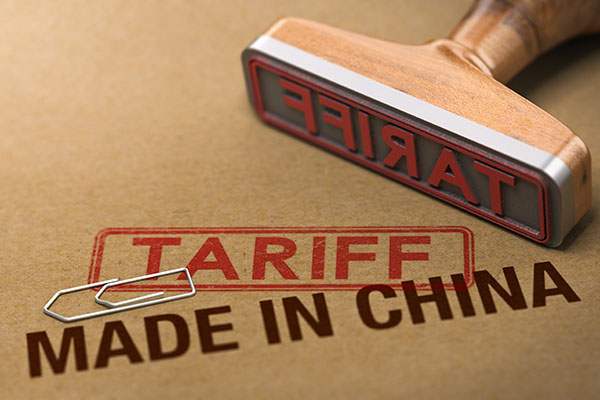With pre-tariff push passed, imports see lower volumes, reports Port Tracker
The push to beat pending tariffs on goods imported from China, which has been a major theme in global shipping for the last several months, showed signs of slowing in the most recent edition of the Port Tracker report.

The push to beat pending tariffs on goods imported from China, which has been a major theme in global shipping for the last several months, showed signs of slowing in the most recent edition of the Port Tracker report issued by the National Retail Federation (NRF) and maritime consultancy Hackett Associates earlier today.
The ports surveyed in the report include: Los Angeles/Long Beach, Oakland, Tacoma, Seattle, Houston, New York/New Jersey, Hampton Roads, Charleston, and Savannah, Miami, Jacksonville, and Fort Lauderdale, Fla.-based Port Everglades.
Authors of the report explained that cargo import numbers do not correlate directly with retail sales or employment because they count only the number of cargo containers brought into the country, not the value of the merchandise inside them, adding that the amount of merchandise imported provides a rough barometer of retailers’ expectations.
“With the holiday season behind us, the immediate pressure to stock up on merchandise has passed but retailers remain concerned about tariffs and their impact on the nation’s economy,” NRF Vice President for Supply Chain and Customs Policy Jonathan Gold said in a statement. “Retailers have also brought in much of their spring merchandise early to protect consumers against higher prices that will eventually come with tariffs. Our industry is hoping the talks currently under way will bring an end to this ill-advised trade war and result in a more appropriate way of responding to China’s trade abuses that won’t force American consumers, workers and businesses to pay the price.”
For much of 2018 through October, volumes came in to United States-based retail container ports at higher than usual levels with retailers importing merchandise in advance of what was expected to be coming tariff increase in January. But in early December that January increase was put on hold in the form of a 90-day “trade truce” between the U.S. and China that will leave tariffs on more than $200 billion worth of goods imported to the U.S. from China at 10%, rather than the planned increase to 25%.
Port Tracker reported that U.S.-based retail container ports handled 1.81 million TEU (Twenty-Foot Equivalent Units), in November, the most recent month for which data is available. This marks a 2.5% annual increase and an 11.4% decrease compared to October’s 2.04 million TEU, which marked the single highest volume month since the Port Tracker report began tracking retail container import volume in 2000.
The report estimated December’s tally at 1.79 million TEU, which would represent a 3.7% annual increase, which would put 2018 calendar year volume at 21.6 million TEU and mark a 5.3% annual gain compared to 2017’s 20.5 million TEU, the current annual record.
January is pegged at 1.75 million TEU, marking a 0.9% annual decline, and February is expected to hit 1.67 million TEU, also marking a 0.9% annual decline. March is forecasted to reach 1.55 million TEU for a 0.6% annual gain. The report pointed out that February and March are commonly two of the slowest months of the year for imports, due to the post-holiday drop in demand and Lunar New Year factory shutdowns in Asia.
Hackett Associates Founder Ben Hackett wrote in the report that while there have been record-high levels of imports over the past several months, primarily due to raised inventories ahead of expected tariff increases, he expects declining volumes in the coming months and an overall weakness in imports for the first half of the year.
“Consumer debt continues to rise, perhaps in anticipation of higher prices due to tariffs,” he wrote. “Any slowdown in the economy could be sharp as efforts are made to reduce debt, and that will hit imports. The big question, of course, is timing. The impact [may] come in the next 18 months as we are already seeing weaker import volumes. Carriers are doing their best to manage capacity in an effort to keep freight rates-and their income-up but the optimism they held in 2018 appears to be evaporating. New capacity has been delayed but shipyards will only agree to this for a limited time. Freight rates will suffer.”

Article Topics
3PL News & Resources
LM Podcast Series: Assessing the freight transportation and logistics markets with Tom Nightingale, AFS Logistics Investor expectations continue to influence supply chain decision-making XPO opens up three new services acquired through auction of Yellow’s properties and assets FTR’s Trucking Conditions Index weakens, due to fuel price gains LM Podcast Series: Examining the freight railroad and intermodal markets with Tony Hatch Supply Chain Stability Index sees ‘Tremendous Improvement’ in 2023 TD Cowen/AFS Freight presents mixed readings for parcel, LTL, and truckload revenues and rates More 3PLLatest in Logistics
LM Podcast Series: Assessing the freight transportation and logistics markets with Tom Nightingale, AFS Logistics Investor expectations continue to influence supply chain decision-making The Next Big Steps in Supply Chain Digitalization Warehouse/DC Automation & Technology: Time to gain a competitive advantage The Ultimate WMS Checklist: Find the Perfect Fit Under-21 driver pilot program a bust with fleets as FMCSA seeks changes Diesel back over $4 a gallon; Mideast tensions, other worries cited More LogisticsAbout the Author
Subscribe to Logistics Management Magazine

Find out what the world's most innovative companies are doing to improve productivity in their plants and distribution centers.
Start your FREE subscription today.
April 2023 Logistics Management

Latest Resources














